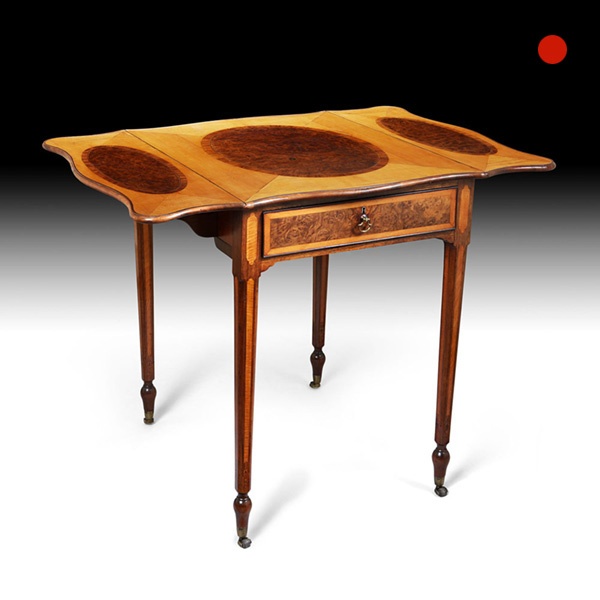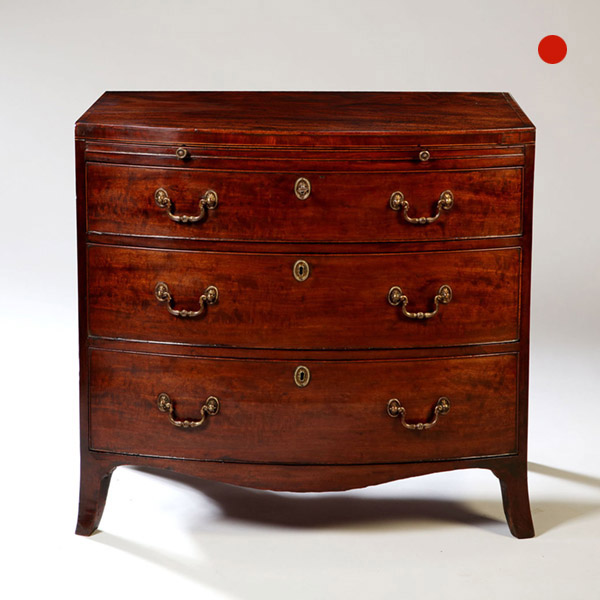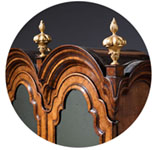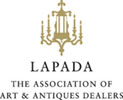An Elegant and Rare George II Pollard Oak and Walnut Card Table, Circa 1740
£15,900
Follow Us
An Elegant and Rare George II Pollard Oak and Walnut Card Table, Circa 1740
An Elegant and Rare George II Pollard Oak and Walnut Card Table, Circa 1740. England
This remarkable George II card table, dating to circa 1740, is a superb example of 18th-century English craftsmanship, blending functionality with exceptional design and materials.
The rectangular top is veneered in striking pollard oak, beautifully cross-banded in walnut and finely strung with ebony and boxwood. Its moulded edge and shaped corners highlight meticulous attention to detail and refinement.
The table opens via the favoured concertina action, revealing a baize-lined playing surface inset with four circular counter wells and corner candle stands, all veneered with the same exquisite pollard oak.
A single drawer, fitted with its original brass escutcheon and handle, offers practical storage for game pieces or cards, maintaining its functional appeal.
The table is raised on four gracefully shaped cabriole legs, each finely carved with acanthus leaves at the knees and tapering to delicate pad feet. The proportions and quality of the carving exemplify the sophistication of George II design.
The table is in excellent condition, retaining its original brass hardware and showcasing a rich, warm patina developed over centuries. The baize playing surface has been sensitively restored to ensure usability while preserving the table’s historical integrity.
Historical Significance:
Card tables such as this were both practical and decorative, serving as elegant focal points in Georgian drawing rooms. Their design and craftsmanship reflect the cultural and social importance of gaming in 18th-century England.
This exquisite table is not only a functional piece of furniture but also a timeless testament to Georgian design. It would make a striking addition to any distinguished collection or interior, exuding elegance and historical charm.
Condition
Good. Wear consistent with age and use.
Dimensions
Dimensions on request.
PREVIOUSLY SOLD

18th Century George III Satinwood and Pollard Oak Pembroke Occasional Table
An exceptionally fine and rare George III satinwood and pollard oak Pembroke table. The padauk top is veneered in satinwood cantered by large ovals of tightly clustered burr pollard oak reserves, bordered in princess wood and lined with fine ebony and box stringing.

George III Sheraton period bow-fronted caddy topped mahogany chest of drawers
A fine George III Sheraton period bow-fronted mahogany chest of drawers with brushing slide. The chest has the perfect time aged colour to its original wax finished surface and has truly commendable proportions. I love everything about this outstanding and original piece.

18th Century George III Satinwood and Pollard Oak Pembroke Occasional Table
An exceptionally fine and rare George III satinwood and pollard oak Pembroke table. The padauk top is veneered in satinwood cantered by large ovals of tightly clustered burr pollard oak reserves, bordered in princess wood and lined with fine ebony and box stringing.

George III Sheraton period bow-fronted caddy topped mahogany chest of drawers
A fine George III Sheraton period bow-fronted mahogany chest of drawers with brushing slide. The chest has the perfect time aged colour to its original wax finished surface and has truly commendable proportions. I love everything about this outstanding and original piece.
YOU MAY ALSO LIKE
No Results Found
The page you requested could not be found. Try refining your search, or use the navigation above to locate the post.
No Results Found
The page you requested could not be found. Try refining your search, or use the navigation above to locate the post.














